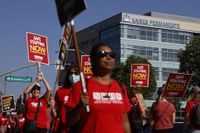Across the United States, the landscape of healthcare is shifting in ways that could have profound effects on both patients and providers. In the Pacific Northwest, Unity Care NW—a federally qualified health center (FQHC) serving nearly 25,000 patients annually in Whatcom and Skagit counties—is bracing for a potential storm. Meanwhile, in California, Kaiser Permanente has announced another round of layoffs, affecting hundreds of employees and stoking unrest among healthcare workers as a massive strike looms. Together, these developments illustrate the mounting pressures facing America’s healthcare safety net at a time when vulnerable populations may need it most.
For Unity Care NW, the challenges are mounting on several fronts. As reported by Cascadia Daily News, the center relies heavily on federal funding to fulfill its mission of providing care to anyone in need, regardless of their insurance status. Nearly 60% of Unity Care’s patients use Medicaid—a vital source of revenue that is now under threat due to looming federal cuts and the ongoing government shutdown. The organization’s chief financial officer, Bonnie Ross, put the situation in stark terms during a recent meeting with Representative Rick Larsen: “The need is so great here, how do we do that?”
The numbers paint a sobering picture. In 2024, Unity Care’s revenue topped $51 million, with expenses just over $48 million. That year, the center served 24,697 patients—half of whom live in rural areas, and more than 48% of whom are at or below the federal poverty line. In fact, 80% of Unity Care’s patients fall at or under 200% of the poverty line, underscoring the critical role the center plays in its community.
Federal grants, which Unity Care applies for every three years, provide about $2 million annually—funds essential for offering primary, dental, and mental health care on a sliding fee scale. But as Medicaid cuts loom, the center is expecting more patients to turn to them for discounted care, even as its own financial footing becomes less secure. Unity Care is set to file its next grant application this month, but the amount is locked in and cannot be increased to meet the anticipated surge in demand.
The prospect of deeper cuts is especially alarming given new Medicaid work or volunteer hour reporting requirements set to begin in 2027. Julia Covert, Unity Care’s enrollment supervisor, highlighted the administrative burden this will place on both staff and patients: “I’m anticipating our team is going to have quite a bit more volume with patients and community members who need to get that paperwork in every six months. We will see more people who lose their Medicaid due to difficulties getting that paperwork in.”
And the stakes are high. Without its federal grant, Unity Care would lose its status as an FQHC, along with access to the discounted 340b prescription drug program, enhanced tax reimbursements, and federal tort claim protections. The ripple effects would be felt far and wide, especially by the thousands of residents who qualify for enhanced premium tax credits. According to Rep. Larsen, these individuals are facing the possibility of 65% premium increases next year if the subsidies expire at the end of 2025—a scenario that hinges on congressional action.
Chris Kobdish, Unity Care’s chief strategy officer, summed up the situation bluntly: “We anticipate we’re gonna have more people that aren’t going to have insurance. There’s going to be more people that are going to need discounted services.” If the center is forced to cut services or staff, the only emergency room in the county—which is already crowded—could see even greater demand. The local hospital, PeaceHealth St. Joseph Medical Center, has already told Unity Care to stop referring pediatric patients due to capacity issues. “They’re even struggling,” Ross noted, highlighting the strain felt across the entire regional healthcare system.
The financial implications are daunting. Unity Care estimates it could lose $4 million in revenue from fewer Medicaid patients alone. In dental care, where about 80% of patients use Medicaid, a 10-20% loss in that payer mix could mean another $2 million hit. Ross posed the difficult questions facing the organization: “We’re looking at it as, what do we do? How do we start planning for this? Where do you cut those expenses? You still need the supplies.”
While Unity Care and similar centers in Washington grapple with these existential threats, a different but related crisis is unfolding in California. Kaiser Permanente, one of the nation’s largest nonprofit healthcare providers, has announced layoffs affecting more than 200 employees across 15 hospitals and clinics. According to WARN notices filed with the California Employment Development Department, the cuts took effect September 17, 2025, and affect major facilities in Oakland, Pleasanton, San Leandro, Pasadena, and Redwood City, as well as smaller sites across Los Angeles, Riverside, and San Diego counties.
Most of the 184 employees notified in Northern California worked in IT and food services. Kaiser described the layoffs as part of ongoing efforts to “rebalance resources” and adapt to changing patient volumes and rising costs. Lena Howland, the company’s senior media relations and PR representative, emphasized the gravity of the decision: “We do not make these decisions lightly. The people affected have made important contributions to Kaiser Permanente, and we’re helping them transition into other roles where possible.”
Kaiser employs about 180,000 people in California, but the timing of these layoffs has heightened tensions with workers. More than 30,000 nurses and health professionals are planning to strike on October 14, 2025, in what could become the largest strike in the company’s history. Kaiser, headquartered in Oakland, insists that the layoffs and ongoing negotiations with labor unions will not affect the quality of patient care and services. “It is important to note that none of these changes will affect the quality of Kaiser Permanente’s patient care and service, which is always our primary focus,” Howland reiterated.
Despite these assurances, the mood among healthcare workers remains unsettled. Many see the layoffs as emblematic of broader challenges in the industry—where rising costs, shifting payer mixes, and policy uncertainty are forcing difficult choices that could ultimately impact the most vulnerable patients.
As Unity Care NW, Kaiser Permanente, and countless other providers navigate these turbulent waters, the future of accessible, high-quality healthcare for low-income and working-class Americans hangs in the balance. The coming months—and the decisions made by policymakers, hospital administrators, and labor leaders—will shape not only the fate of these institutions, but also the well-being of millions who depend on them.




